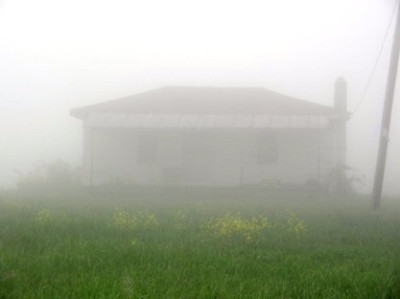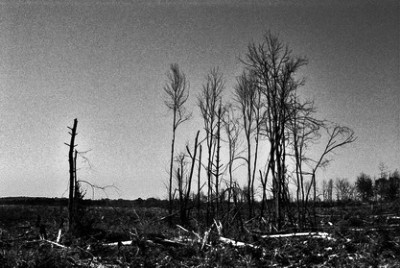
As we come up the ridge the fog thickens. Our headlights burn dimly through the milky-white morning and visibility is down to something less than 500 feet. Out of the soup, on the side of the road, a shack takes form then quickly recedes again, like some strange specter. Walden’s Ridge, when the fog is thick, seems to be made of cloud. Or perhaps it is part of the clouds, the massive waves of mist breaking free of the forest and rising up through the trees, rejoining the sky.
But by the time we reach our survey site the fog is burning off and the barren clearcut has come into view. We put on our packs, set our GPS coordinates, and start the walk down the valley toward the creek. Once at the bottom we will start back up again. This will be repeated, up and down, back and forth, until we are out of time or stamina or both.
The work is hard and dangerous, though not as dangerous here as it will become elsewhere. There are sheer bluffs to be scaled and then descended again. The terrain is steep and rocky at best, impassable at worst. Yet the forest, a second or third-growth mix of oak, maple, poplar, and hemlock remains majestic, punctuated by rocky falls and cliffs.
 We stop for lunch in a running creek and eat perched on boulders that must have tumbled down into the valley thousands upon thousands of years ago. As we eat I spot an eastern box turtle perched on a ledge of rock, both of its feet hanging over the edge, as if unsure how to proceed. I take my camera out of my pack and begin to photograph the animal, the state reptile of Tennessee. I am pleased that it is holding its unusual pose and soon my partner comes up to take some pictures as well. We discuss angles and compare shots, both laughing at the strange posture of the old turtle. Finally, something occurs to me and I gently prod the turtle with my boot. It does not move. I pick the turtle up and it doesn't withdraw its head nor clamp its shell down tight, as would be normal. It merely blinks at me, slowly and sadly; it is dying.
We stop for lunch in a running creek and eat perched on boulders that must have tumbled down into the valley thousands upon thousands of years ago. As we eat I spot an eastern box turtle perched on a ledge of rock, both of its feet hanging over the edge, as if unsure how to proceed. I take my camera out of my pack and begin to photograph the animal, the state reptile of Tennessee. I am pleased that it is holding its unusual pose and soon my partner comes up to take some pictures as well. We discuss angles and compare shots, both laughing at the strange posture of the old turtle. Finally, something occurs to me and I gently prod the turtle with my boot. It does not move. I pick the turtle up and it doesn't withdraw its head nor clamp its shell down tight, as would be normal. It merely blinks at me, slowly and sadly; it is dying.
We return to our lunch, the photos no longer as enchanting. When we are about to move on I leave a bit of apple for the turtle. It moves its head slightly, but that is all. Soon it will be dead. But we have other things to worry about.


As we drive west from Highway 27 I look up at the ridge high above and immediately begin to wonder what I’ve gotten myself into. We cross the railroad tracks and drop down into the flats, black-green with the dense vegetation. The brown, ropy, kudzu vines twisting up and over anything in their path have not yet leafed-yet. Once they do, even more of this already secretive and shadowy land will be obscured.
Off the narrow roads, nestled in the foliage, are homes. Some of the homes are ramshackle, wooden affairs with chipped and peeling paint. Many residences are trailers, some of which seem to be unlivable. The yards are often nothing more than dirt, the grass worn away, with all manner of animals, children, and appliances strewn about. Some are nearly totally obscured by cars, beaten hulks sitting wheel-less on cinder blocks, the various components removed and laid nearby, as if they might somehow be useful once again. In many yards there are fires, and thin wisps of gray smoke waft through the trees as litter and debris smolders. Later I am told that Rhea County is one of the poorest counties in Tennessee. Despite this apparent poverty, most residences have a late model car or truck parked nearby, a sign of the primacy of movement in the modern age, a necessity requiring any cost or privation.

Everywhere there are churches of all denominations and creeds; Evangelical, Pentecostal, Methodist, and, naturally, Baptist. The church buildings are of all shapes, sizes, and conditions, and the sheer number of them makes it difficult to believe there are enough people to support them all. Yet each must have their congregants and outside these places of worship, as well as hung in front of homes and nailed to various trees, there are signs: “Prepare to meet thy God,” Know Jesus, know peace; no Jesus, no peace,” and often simply, “Repent!”
We pass through and begin to climb Walden’s Ridge, the road a steep switchback. Once on top you can see clear across the Tennessee Valley, the river snaking into the distance, the mountains of North Carolina on the horizon. The roads we travel are used by no one save the people who live near them. On top of the ridge are farms, horse lots, and immaculately rendered homes that resemble old-fashioned log cabins. We follow a dirt road alongside a farm, cows watching us from the field adjacent, and pass through a gate. Beyond the gate is a huge clearcut, the ground littered with shattered timber. Small clumps of scrawny, dead snags dot the landscape. It looks as if a bomb has been detonated on this place.

We park the truck at the end of an old logging road and head toward a pocket of live trees, the terrain too steep and rocky for the logging equipment to have accessed. These are the areas we will be walking and from here on out each will seem steeper and rockier than the one previous. It will not be for the last time that I wonder what I’ve gotten myself into.

 We stop for lunch in a running creek and eat perched on boulders that must have tumbled down into the valley thousands upon thousands of years ago. As we eat I spot an eastern box turtle perched on a ledge of rock, both of its feet hanging over the edge, as if unsure how to proceed. I take my camera out of my pack and begin to photograph the animal, the state reptile of Tennessee. I am pleased that it is holding its unusual pose and soon my partner comes up to take some pictures as well. We discuss angles and compare shots, both laughing at the strange posture of the old turtle. Finally, something occurs to me and I gently prod the turtle with my boot. It does not move. I pick the turtle up and it doesn't withdraw its head nor clamp its shell down tight, as would be normal. It merely blinks at me, slowly and sadly; it is dying.
We stop for lunch in a running creek and eat perched on boulders that must have tumbled down into the valley thousands upon thousands of years ago. As we eat I spot an eastern box turtle perched on a ledge of rock, both of its feet hanging over the edge, as if unsure how to proceed. I take my camera out of my pack and begin to photograph the animal, the state reptile of Tennessee. I am pleased that it is holding its unusual pose and soon my partner comes up to take some pictures as well. We discuss angles and compare shots, both laughing at the strange posture of the old turtle. Finally, something occurs to me and I gently prod the turtle with my boot. It does not move. I pick the turtle up and it doesn't withdraw its head nor clamp its shell down tight, as would be normal. It merely blinks at me, slowly and sadly; it is dying. 


